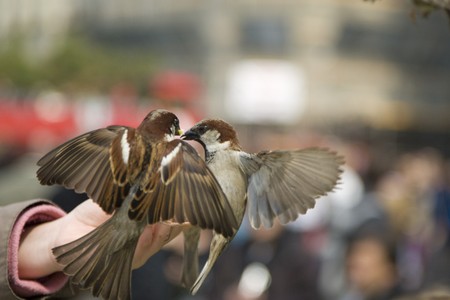1. Understanding Your Birds Species and Ability to Talk
Different bird species have varying abilities to mimic human speech. Some birds are naturally more inclined to learn words, while others may only pick up a few sounds or phrases. Understanding your birds species and its natural behaviors can help you set realistic expectations and tailor your training methods effectively.
Best Talking Bird Species
Certain bird species are well-known for their ability to mimic human speech. Below is a table highlighting some of the best talking birds along with their speech potential:
| Bird Species | Speech Ability | Characteristics |
|---|---|---|
| African Grey Parrot | Excellent | Highly intelligent, extensive vocabulary, clear pronunciation |
| Amazon Parrot | Very Good | Loud and expressive, strong mimicking skills |
| Budgerigar (Parakeet) | Good | Can learn many words but often speaks in a softer voice |
| Cockatoo | Moderate | Able to mimic some words but focuses more on sounds and tones |
| Mynah Bird | Very Good | Mimics words and sounds with impressive accuracy |
The Role of Natural Behavior in Speech Learning
A bird’s ability to talk is influenced by its natural behavior and social tendencies. Parrots, for example, are social creatures that communicate frequently in the wild, making them more likely to develop strong speaking skills. Birds that thrive on interaction and bonding with humans are generally better at learning words.
The Importance of Repetition and Imitation
The best talking birds learn through repetition and imitation. They pick up on frequently used words and phrases, especially those spoken with enthusiasm. Birds that are exposed to daily conversation and interactive training tend to develop better verbal skills over time.
Selecting the Right Bird for Talking Training
If youre looking for a bird that can talk, consider one of the species listed above. Keep in mind that every bird is unique, and even within the same species, individual birds may have different levels of interest in mimicking speech.
2. Creating the Right Learning Environment
A stress-free, engaging, and interactive atmosphere is crucial for teaching birds to talk. Birds learn best when they feel safe, comfortable, and stimulated by their surroundings. Here’s how you can create the perfect learning environment for your feathered friend.
Provide a Quiet and Comfortable Space
Birds are highly sensitive to their surroundings, so its important to place their cage in a calm area of your home. Avoid high-traffic zones with loud noises or sudden disturbances that could cause stress.
Ideal Cage Placement
| Do | Dont |
|---|---|
| Place the cage in a quiet room where the bird can still interact with family members. | Put the cage near loud TVs, speakers, or areas with frequent movement. |
| Ensure natural light exposure but avoid direct sunlight. | Place the cage in front of air vents or drafty windows. |
| Keep the space clean and free of strong odors or smoke. | Expose the bird to household chemicals or scented candles. |
Encourage Interaction and Socialization
Birds are social creatures that thrive on interaction. Regular engagement with your bird helps them develop confidence and encourages vocalization. Talk to your bird often using clear and consistent words, reinforcing their learning process.
Best Ways to Interact
- Sit near their cage and speak gently throughout the day.
- Use repetition—say the same words consistently to help them recognize sounds.
- Praise them when they make an attempt at speech, even if it’s not perfect.
- Avoid overwhelming them with too many words at once; start simple.
Add Stimulating Toys and Sounds
A bored bird is less likely to engage in learning. Providing stimulating toys, mirrors, and background sounds like soft music or recorded phrases can encourage speech development.
Recommended Items for Learning
- Talking Toys: Some toys are designed to repeat words back to your bird.
- Mirrors: Helps birds feel like they have company, encouraging vocal practice.
- Soft Background Music: Can create a relaxed atmosphere for learning.
Create a Routine for Learning Sessions
Consistency is key when teaching your bird to talk. Set up daily training sessions where you focus solely on speaking with them. Keep these sessions short but frequent—about 5-10 minutes at a time—so they don’t get overwhelmed.
Tips for Effective Training Sessions
- Choose a specific time each day: Birds learn better with routine.
- Use positive reinforcement: Give treats or praise when they make an effort.
- Avoid distractions: Turn off background noise during training sessions.
By creating a safe, engaging, and structured learning environment, youll significantly improve your birds ability to pick up new words and phrases over time. A happy and comfortable bird is much more likely to talk!

3. Using Repetition and Positive Reinforcement
Consistently repeating words and rewarding your bird for progress strengthens their ability to mimic speech. Explore effective techniques for reinforcement.
The Power of Repetition
Birds learn best through repeated exposure to sounds and words. The more frequently they hear a word, the more likely they are to mimic it. Try these repetition strategies:
- Use Simple Words First: Start with short, clear words like “hello,” “bye,” or your bird’s name.
- Repeat Daily: Say the word multiple times during each interaction with your bird.
- Associate Words with Actions: If you say “treat” while offering a snack, your bird will connect the word with the reward.
- Maintain a Consistent Tone: Using the same pitch and tone each time helps reinforce learning.
Positive Reinforcement Techniques
Praising and rewarding your bird when they attempt to speak encourages them to continue learning. Here are some effective reinforcement methods:
| Technique | Description |
|---|---|
| Treat Rewards | Give a favorite treat when your bird successfully mimics a word. |
| Praise and Affection | Say “Good job!” or give gentle petting to reinforce their effort. |
| Toy Rewards | If your bird enjoys playing, offer a toy as a reward for speaking attempts. |
| Clicker Training | A clicker sound followed by a treat helps associate speech attempts with positive outcomes. |
Avoiding Common Mistakes
- Don’t Overwhelm Your Bird: Stick to one or two words at a time before introducing new vocabulary.
- Avoid Negative Reactions: Never punish or scold if they don’t get it right—patience is key!
- Create a Positive Learning Environment: Ensure training sessions are fun, engaging, and stress-free.
The Role of Daily Interaction
The more you talk to your bird throughout the day, the faster they’ll pick up on words. Regular engagement makes learning natural and enjoyable for them.
4. Choosing the Right Words and Phrases
Short, clear, and frequently used words are easiest for birds to learn. Picking the right words can make a big difference in how quickly your bird starts talking. Here’s how to choose the best words and phrases for early success.
Start with Simple and Common Words
Birds learn best when they hear the same words repeatedly. Start with simple words that you use often in daily conversations. Here are some good beginner words:
| Category | Examples |
|---|---|
| Greetings | Hello, Hi, Bye |
| Affectionate Words | Love you, Good bird |
| Commands | Step up, Come here |
| Fun Sounds | Peekaboo, Yay! |
Avoid Complex or Confusing Words
Avoid long or complicated words when starting out. Birds may struggle with difficult syllables or unfamiliar sounds. Stick to short, clear phrases that are easy to pronounce.
Use Words Your Bird Hears Every Day
Your bird will learn faster if it hears the same words consistently. Try using words during feeding time, playtime, and daily interactions. For example:
- If you say “Good morning” every day when uncovering the cage, your bird may pick it up.
- Saying “Treat!” before offering a snack can help your bird associate the word with food.
- If you always say “Bye-bye” before leaving, your bird may start repeating it.
Add Fun and Excitement to Learning
Your tone matters! Birds respond well to enthusiastic and happy voices. Use an excited tone and repeat words cheerfully to encourage your bird to mimic you.
5. Building a Daily Training Routine
Regular, short training sessions help birds retain words better. Creating a structured daily routine can make a significant difference in your bird’s ability to learn and repeat words. Here’s how you can set up an effective training schedule.
Keep Training Sessions Short and Consistent
Birds have short attention spans, so keeping each session brief—about 5 to 10 minutes—is ideal. Aim for at least two or three sessions per day to reinforce learning.
Choose the Right Time for Training
The best time to train your bird is when they are alert and active. Typically, morning and early evening work well since birds tend to be more engaged during these times.
Create a Comfortable Learning Environment
A quiet space with minimal distractions will help your bird focus on learning new words. Turn off loud noises like TV or music and ensure the bird feels safe and comfortable.
Use Repetition and Positive Reinforcement
Repeating words clearly and consistently helps your bird remember them. Rewarding successful attempts with treats or praise encourages them to keep trying.
Sample Daily Training Schedule
| Time | Activity |
|---|---|
| 8:00 AM | Morning training session – Introduce or repeat key words |
| 12:00 PM | Casual reinforcement – Talk to your bird naturally during interactions |
| 6:00 PM | Evening training session – Practice learned words with rewards |
Be Patient and Adapt as Needed
Your bird may take time to learn new words, so patience is key. If progress is slow, adjust the routine by simplifying words or increasing positive reinforcement.
6. Common Challenges and How to Overcome Them
Some birds take longer to talk than others. While some pick up words quickly, others may face obstacles that slow their progress. Below are common challenges bird owners encounter when teaching their feathered friends to speak, along with solutions to help overcome them.
Lack of Interest
If your bird doesn’t seem interested in learning to talk, it could be due to boredom or a lack of motivation. Here’s how you can spark their interest:
- Use Their Favorite Treats: Reward your bird with a treat every time they attempt to mimic a sound or word.
- Engage with Enthusiasm: Birds respond well to energy. Speak in an excited and cheerful tone.
- Find Words They Like: Some birds prefer certain sounds over others. Experiment with different words and see which ones catch their attention.
Easily Distracted
A noisy environment or too many distractions can make it difficult for a bird to focus on learning speech. Try these strategies:
- Create a Quiet Learning Space: Reduce background noise such as TV, music, or other pets during training sessions.
- Train at the Right Time: Birds learn best when they’re alert and engaged, typically in the morning or after a nap.
- Keep Sessions Short: Birds have short attention spans, so keep lessons brief—5 to 10 minutes at a time.
Fear of Speaking
If your bird appears hesitant or shy about making sounds, they may need more encouragement and reassurance.
| Fear Factor | Solution |
|---|---|
| Nervous Around People | Spend more time bonding with your bird through gentle interaction before introducing speech training. |
| Lack of Confidence | Praise and reward any vocal attempts, even if they aren’t clear words yet. |
| Sensitivity to Loud Sounds | Avoid sudden noises and create a calm environment where your bird feels safe. |
Your Bird Isn’t Making Progress
If you’ve been consistent but haven’t seen much improvement, don’t get discouraged. Consider these adjustments:
- Repeat Key Words More Often: Repetition is crucial for birds to learn new words.
- Mimic Their Sounds First: If your bird makes its own noises, imitate them first before introducing new words.
- Tone Matters: Birds often respond better to higher-pitched or exaggerated tones.
Every bird learns at its own pace, so patience is key. Keep sessions fun, rewarding, and stress-free, and soon enough, your bird will start picking up new words!


